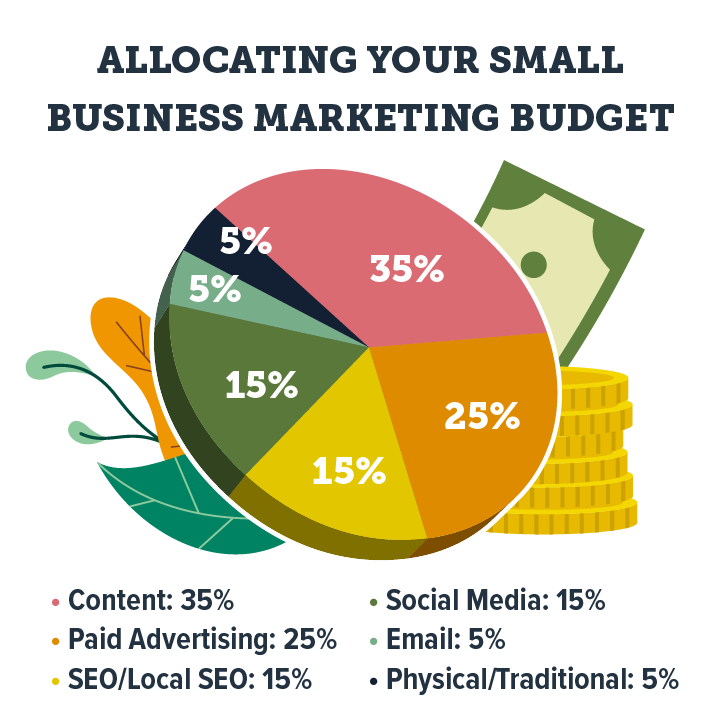Since every business is unique, there’s no “right” answer to how much a small business should spend on marketing every year. But there is a wrong answer—zero dollars. Small business marketing may seem like an unnecessary investment, especially since startups can be costly, but ignoring marketing altogether is a major reason small businesses fail. Here’s what you need to consider when creating your small business marketing budget.
- What’s the Average Marketing Budget for Small Businesses?
- What Impacts a Small Business Marketing Budget?
- Tips for Creating a Small Business Marketing Budget
What’s the Average Marketing Budget for Small Businesses?
Most small businesses have an average marketing budget of 13.8% of their total budget and 8.7% of their total revenue, but putting aside anywhere from 7% to 15% of your gross revenue is a good rule of thumb for your small business marketing budget. The size of your business, your industry, how long you’ve been open, and many other factors play into how much you should set aside for marketing, though.
What Impacts a Small Business Marketing Budget?
These factors can help you figure out what your small business marketing budget should be.
Audience & Offerings
What you’re marketing and who you’re marketing to can be big factors in your small business marketing budget. On average, companies spend more on B2C marketing budgets than B2B marketing budgets. Similarly, product-based companies typically allocate more to marketing than service-based companies. Here’s a comparison of total revenue spent on marketing for B2B and B2C companies by offering.
| Product | Service | |
| B2B | 7.8% | 5.9% |
| B2C | 15.1% | 6.5% |
There are a couple reasons marketing budgets for B2B companies can be less than B2C companies. A company that sells products to everyday people usually sells them at a lower price than products and services sold to corporations–so B2C companies have to reach more people to generate income.
B2B small business owners can also appeal more to logic, rather than the emotion it takes to persuade B2C audiences. Appealing to emotions takes branding and messaging through marketing channels you may not be an expert in–requiring you to spend more money on external sources. Alternatively, teaching businesses about your products and services is exactly in your wheelhouse as the small business owner, which might mean you can do the marketing work yourself to save money.
Industry
The average marketing budget by industry varies widely. You might have to spend more on marketing if your industry:
- Is highly competitive
- Relies on luxury products/services
- Caters to generic, wide-spread audience demographics
- Requires more technical explanation
- Takes longer to convert customers
- Operates seasonally
Below is the average marketing budget percentage by industry based on total revenue:
- Beverage production: 2.73%
- Construction: 4.67%
- E-commerce: 15.27%
- Finance: 5.6%
- Health care: 9.56%
- Real estate: 3.84%
- Restaurants: 1.93%
- Retail: 12.07%
If your industry isn’t included on this list, use the Library of Congress’ marketing industry reports to find the average marketing budget for small businesses like yours.
Revenue
By using a percentage of revenue as a guide for how much to spend on marketing, you can avoid overspending and jeopardizing your financial stability. As your small business grows and its revenue increases, your marketing budget can automatically adjust (unlike a fixed dollar amount), allowing you to maintain a consistent level of marketing effort. In other words, using revenue as a benchmark for your small business marketing spend ensures that your efforts remain strategic and effective even as the business scales up.
Usually, as your annual revenue grows, your marketing spend can decrease, like this:
- Less than $1 million: 7-8%
- $1-5 million: 5-7%
- $5+ million: 4-6%
Internal Resources
When you’re planning out your small business marketing strategies, how will you implement them? Do you have enough personnel with the right expertise to execute your strategies? If so, their salaries need to factor into your small business marketing budget. And if not, you’ll have to outsource the work to freelance graphic designers or marketing agencies. Obviously, contracting help for your content marketing strategy, brand design, and web design will all add to your budget.
Here’s the typical marketing budget of small businesses based on their number of employees:
- Less than 50: 16%
- 50-99: 13.4%
- 100-499: 8.7%
- 500-999: 6.7%
- 1,000+: 5%
Along with in-house or external labor, you may even use marketing tools and software for marketing. There are plenty of free SEO tools on the market, but email marketing platforms, SEO analytics software, and CRM and CMS platforms can all cost money to use their full access and capabilities. As always, based on the needs of your company, your budget for these tools will vary, but you can plan to spend around 5-10% of your marketing budget on tools and software.
Marketing Channels
Organic marketing channels like local search engine optimization, local citations, content marketing, social media marketing, building a business website, and email marketing are almost always free (or very low cost) if you do them yourself. But this is generally the cost of marketing services if you need to hire outside assistance:
- Content: $2,000-$10,000 per month
- Email: $300-$1,500 per month
- Paid Advertising: $9,000-$10,000 per month
- SEO/Local SEO: $1,500-$5,000 per month
- Social Media: $4,000-$7,000 per month
- Web Design: $1,000-$100,000 per project
If you’re on a tight budget and looking for ways to cut down your online marketing costs, it might be tempting to only use organic marketing strategies. However, these free opportunities take time to have a significant impact on your business, while paid advertising generates more immediate results. To be successful, you should use both to supplement your short-term and long-term growth.
You should also leave room in your small business marketing budget for traditional marketing channels, like promotional products, billboards, vehicle wraps, flyers and leave-behinds, radio advertisements, and more. Sometimes, you can even get free publicity through local news coverage, or you could spread the word about your business by volunteering in your community.
Years in Business
As a new company, you’re likely starting your marketing from scratch. To establish an online presence, grow your brand awareness, and generate sales quickly, you’ll need to invest quite a bit of capital to grow quickly. On the other hand, an established business might be more focused on retaining clients, which costs less than attracting new customers.
The average marketing budget for startups in their first few years of business is 12% to 20% of projected gross revenue. Once a small business is more established (around the five year mark), that percentage can decrease to 6% to 12%, as established businesses don’t need to market a ton with a loyal customer base.
Tips for Creating a Small Business Marketing Budget
After considering factors that impact how much money you should spend on your small business marketing, you’ll still need to actually make, track, and refine your small business marketing budget over the years. Here’s how.
Use Free Marketing Budget Templates
A great way to save money (that can go back into your marketing budget) is to avoid paying too much for budgeting software. Instead, here are a few free marketing budget templates small businesses can use:
- SCORE Annual Marketing Budget Template
- Google Sheets Annual Business Budget
- Microsoft Office Business Budget Templates
- Capterra’s Free Small Business Budget Template
Think in Percentages, Not Dollars
Your annual small business marketing budget shouldn’t be a set number, as fluctuations in the economy, your company’s revenue, and the changing costs of marketing channels like PPC advertising can make a simple dollar amount quickly obsolete. But that still leaves small business owners with a question of how to calculate their marketing budget. If you measure your budget as a percentage, it adjusts better with these changes and stays accurate longer.
To give you an idea of why this is important, here’s how the CPMs of a few marketing platforms have increased in recent years:
- Facebook/Meta: 61%
- Snapchat: 64%
- TikTok: 92%
If you use a fixed budget, it won’t scale up at the rate these platforms are increasing in cost–you’d need to constantly watch for the smallest change on any platform. You’ll run into the same thing as your business revenue increases year over year if you use a static budget. Compare the below examples of a business that grows from $50,000 revenue in year one to $100,000 in year two and $250,000 year three:
- Business A ($5,000 fixed annual marketing budget): $5,000 year one (10%), $5,000 year two (5%), $5,000 year three (2%)
- Business B (10% annual marketing budget): $5,000 year one (10%), $10,000 year two (10%), $25,000 year three (10%)
Allocate Your Marketing Budget Strategically
Don’t put all your eggs in one basket. If you flood all of your budget into one marketing channel and it fails, you’ve flushed all that money down the drain with no return on your investment. Besides, your target audience won’t all be found in one place anyway, so you need to spread your efforts–and your budget–across the marketing channels your customers use to reach as many qualified leads as possible.
Not every business’ marketing budget allocation will be the same, but you could follow this general guideline:

For startups that need web design services, you might redistribute your first-year marketing budget to accommodate the one-time fee.
To make your marketing budget allocation best practices more customized to your business, you need data insights. Research your competitors, target audience, and popular keywords to decide where you should have a presence and what key phrases you need to use. Once you’ve established an online presence, you can use marketing analytics from channels like your website, social media accounts, and emails to know if you should invest more or less in each channel.
Track the Right Metrics
There are two main metrics you should track to judge the effectiveness of your small business marketing budget:
- Customer Acquisition Cost (CAC): The total cost to convert one new customer, including all related marketing, branding, personnel, and software expenses. CAC = total marketing expenses / customers acquired.
- Return on Investment (ROI): The total profit generated from investments in different marketing strategies. ROI = (growth in sales – marketing cost) / marketing cost.
There are also a few marketing metrics that will define your budget. Things like CPC on search engines and social media, as well as impressions are what paid marketing channels use to charge small businesses, but they can also fluctuate. Keeping track of these metrics helps you remember how much you’re paying.
To maximize your marketing budget, aim to increase marketing ROI as much as possible and decrease CAC. If a certain marketing channel is consistently low on ROI or high on CAC, consider pausing your efforts there and focusing more of your budget on a channel that generates higher marketing ROI and requires a lower CAC. If you reassess and reallocate your efforts in this way, it can help you optimize the effectiveness of your small business marketing budget and avoid cutting funds entirely.
Know When to Adjust
If your small business’ sales are dropping and you’re losing money, your first instinct could be to conserve money by taking away from your marketing budget. However, it could be more effective to boost your marketing funds to pull in more customers and generate more sales.
When you don’t have a catalyst like a sales drop, it’s still important to keep your small business marketing budget updated. For the first year, reviewing your budget every few months can help you make sure nothing is sucking up too much of your marketing spend. From then on, reviewing every year is best practice, but isn’t the end-all-be-all.
After all, you could have increased traffic during the holidays or operate seasonally. New marketing tools or channels that get popular mid-year could also constitute a review. In cases like these, reevaluating your business marketing plan at least a month before anticipated changes will give you time to make changes.
If you can’t anticipate a change properly, don’t worry! Things like sudden rises in costs of services or supplies and even natural disasters can make it necessary for a budget adjustment on the fly. Prioritize a review as soon as possible when things like this happen.
Need help establishing marketing strategies that’ll make the most impact for your small business? Local Search Fuel by Hurrdat has an expert team of local SEO experts to give you advice, as well as affordable local search starter deals and local SEO services to get you going. Get started today!
Budgeting statistics from Deloitte’s CMO Survey and Small Business Trends.

Stefanie Vanderbeek
Stefanie Vanderbeek is a content strategist and writer who specializes in long-form digital content and website SEO optimization. Stefanie earned her Bachelor of Journalism from the University of Nebraska-Lincoln in Advertising and Public Relations in 2021. In her free time, you can find Stefanie reading, deep diving into video game lore, singing in her professional vocal group, or traveling the world!
